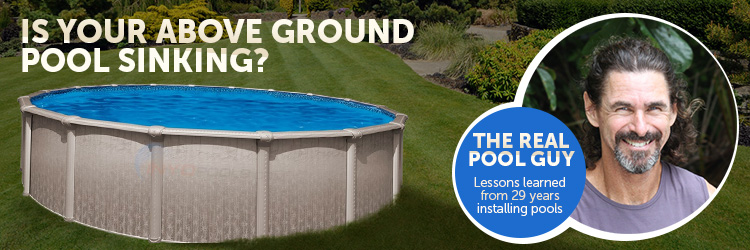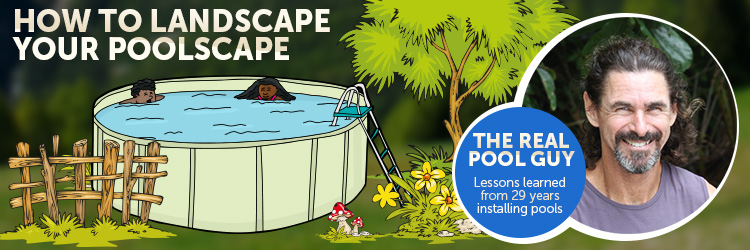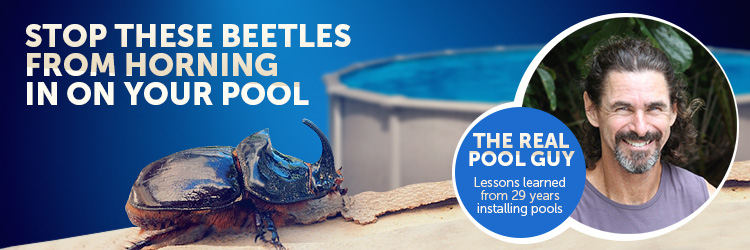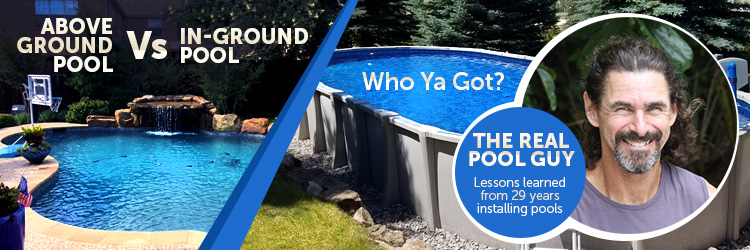In-ground swimming pools have become super expensive. Here in Central Florida where concrete type in-grounds are the most popular, their price has gone through the roof. These pools usually start with a price tag of $30 000, but then go way up from there. It’s not at all uncommon to pay more than $50 000 for an average size concrete in-ground and that’s not even a very big or fancy one.
Because of this crazy cost of in-grounds, homeowners are finding a less expensive option by getting an above ground pool and sinking it in the ground. I have seen above grounds in the ground for many years and it’s nothing new, but it has certainly become much more popular in the last 10 years or so. It seems like at least one person asks me about this every day. So, if you are considering sinking an above ground swimming pool in the ground, you’ve found the right blog post.
Sinking an Above Ground Pool 101
Here’s a list of the basics of placing an above ground pool in the ground. Follow these basics and things will probably go well and you’ll be happy. If you don’t follow them, you might still come out happy. Who knows?
I. Only go down about halfway
These pools aren’t called “above grounds” just ’cause it’s catchy. Above ground swimming pools are not designed for inward pressure. So, when you put them in the ground, they can cave in from the weight of the earth, but only when they are empty. By sinking the pool down only halfway (2-2.5 ft), the pool has a much less likelihood of caving in when the time comes to drain the pool while installing a replacement liner.
If your ground is super firm, it won’t matter much how far down you go. In Central Florida it’s mostly sand-based so that’s an issue, but if you have rocky, rooty, or earth with a lot of clay, you may be fine to go down further. Some will go with the extra cost of building a retaining wall all the way around the pool. If you do that then you’re also good, but that adds to the cost of the job and aren’t you wanting a much cheaper alternative to an in-ground?
Also, most who sink their pool will have a wood deck built around it. Wood decks require some height off the ground so its structure can be built and that’s another good reason to go only halfway down.
II. The hole has to be bigger than the size of the pool
Above ground pools are assembled on site. They can’t be “pre-built” somewhere cool and then helicoptered in and set down into a hole perfectly. The thing has to be built in the hole so more room is needed. As a guideline, if the pool is going two or more feet down, make the hole 1.5’ bigger than the size of the pool all the way around. EXAMPLE: A 24’ round pool should have a hole that is at least 27’ in diameter.
Make sure the bottom of the hole is the desired size and not the top. I know that sounds stupid, but it’s not. A lot of times, holes get dug with a starting top dimension of 27’ round and by the time the hole is two feet down, its dimension has tilted in and it ends up being a 26’ hole at the bottom. Additionally, if your earth is really sandy and loose, it may be a good idea to make the hole even bigger. There’s little more frustrating than building one of these pools in a hole and it caves in on you halfway through with loose earth.

III.Leave piles of earth right next to the hole
After the pool is built and full of water, you’ll want to backfill some dirt around the pool. Remember the hole was bigger than the pool? Leaving some earth close to the hole will make backfilling much easier. Warning: Backfilling before the pool is full of water will result in the wall caving in! Don’t start backfilling too early. Let the pool fill with water so the water’s outward pressure will keep the pool wall in place. I know this sounds like a “duh” statement, but believe me it’s happened more often than I want to admit.
IV. Above ground pool pumps have to stay below the waterline
There are a few differences between in-ground pool pumps and above ground pumps. The biggest one is that an above ground pool pump cannot draw water up. This means that the above ground pump has to be at a level lower than the pool’s water level in order to work properly. If you are placing your above ground in the earth, make sure your pump stays below the pool. You can have your equipment well above the pool, but you’ll have to buy the more expensive in-ground pump to do so. Just another reason to go only halfway down (add this to the first guideline).
V. Check for local safety guidelines
For some towns or counties, an above ground swimming pool is considered safe because they are so high off the ground. With a safety ladder, above ground pools can be pretty safe for any small children wandering along the countryside unsupervised. Though, when you sink the pool that changes. If you don’t have a fence around your yard or if wandering two-year-olds are a problem in your area, then consider this safety issue.
Honorable Mention
So many people ask me if an above ground pool will last as long when it is buried in the ground. Some feel that sinking one in the earth will make it rust out faster or something. It makes logical sense to think that is what will happen, but there is one thing that is more accurate than logical sense and that’s long-term observation. In my 30 years of working on these pools, I have seen no evidence that placing them in the ground takes any life out of them. Of course there are instances where that can be true, but I’m talking as a general rule. Now some disagree with me on this and that’s OK. It’s healthy to be wrong sometimes. Most of them haven’t observed above grounds apart from their own or maybe an uncle’s or neighbor’s or something.
Go ahead and install an above ground in the ground. You may enjoy it more as it won’t be located so high up in your yard.












Hi Dan. In the process of installing my 30′ round pool. My question today is about the backfill. I am setting it in the ground in my sloping yard. Upper part is right around 3′ and then it will slope down to 1′, so I will have backfill against the pool on the upper part 3′ deep sloping down the sides to 1′ of backfill. My soil here has a ton of clay in it. I have read some places that say not to use clay for backfill, but I see you say that clay can be backfilled deeper since its more stable. Do you think I’m ok with my situation, or do you have any different suggestions for backfill? Thanks, Dustin.
Hi,
We live in south east Louisiana and just had an 18×33 ft pool installed. It is above the ground not sunk. My questions are what kinds of shrubs or plants can I put around the pool? My choice would be boxwoods and gardenias since they have shallow roots. We’ve heard about roots possibly going under the liner and creating problems. Also, we’ve put rubber mulch around the perimeter. Is this a safe material to use?
Hello, I’m going to be putting my above ground pool 18inches in ground…I didn’t buy the ppb4000, since they said putting it down in ground would keep from getting moles into it…but do you think I should?? It was going to be 800 more so I opted not to
I live in Texas. We have gumbo dirt that shifts an inch or two a year, maybe more if it rains a lot. If I dig, level, and pack the bottom with a packer, how much sand would you put under the pool and how much ground shift is ok? Would you pack the sand as well? What about the rectangle pools I see online? Can they be sunk as well? How do you fight the hole filling with water outside of the pool? Thanks for all the advice in the blog and thanks in advance for any advice to my questions.
Quick question. I bought a semi above ground pool and excavated about 1ft below ground level (next to pavers in Backyard). It’s a 12×18 oval pool 52″ high. How important is leveling the entire area of dirt (have clay like ground) before I lay down the sand base? I know as I assemble the frame I need to make sure it’s level all the way around, but once I lay the sand inside the perimeter and compact that down, that must be smooth and level.
What’s is most important is that you get the bottom track of the pool level and the correct shape. I do that using blocks under each bottom connector. Once you have that, you can level around the track and inside of it any way you want.
We have an above ground pool that is vinyl. I think I need a pool with a liner to drop it in the ground. Only way to put in a new liner for the one i have is to take it apart. I was hoping it would work but don’t think so. Might be investing in a new pool to be able to put in the ground!
Sorry. Your statement doesn’t make enough sense. And there was no question so I don’t have much of a comment.
Your oh is fabulous. Thank you. We just moved from KS to Tx & left behind a 16×32 with a depth of 52-54” above ground pool. If I remember correctly the pump hole was about 12”from the top. I would like to install a similar one here but our HOA does not allow above ground pools. In reading your blog I get the idea that I can only install 1/2 of pool below the ground. However, if the pump attachment is only 12-18” why would I not be able to install most of the depth below ground, leaving for example & extra 6” below the pump attachment and water skimmer & return. My pool in KS did not have anything at the base or at the bottom of the pool. We also did have enough liner to easily make It deeper in the center. The pool was in use for over 10 years before we left with absolutely no problems – except my complaining husband. LOL. Thanks for your help. Victoria
I only like to bury an above ground half-way down max because of the potential issues when you have to drain the pool to change the liner. If going more than the level of the pump, you can always but a pump that draws water up(like an inground pool pump).
With an 18′ x 40′ above ground oval, what $$$ ballpark would I be looking at, to sink it the recommended depth into the ground? Thank you.
Do you mean just the cost of digging the hole? If so, it depends on where you live. Here in Central Florida, we are mostly sand based so the dig it would cost in the neighborhood of $1200-$1500. I once sold a pool to a customer out west that had to jack-hammer a hole one foot down because they lived on rock. That would run you slightly more.
Hello I just purchased a 16×32 bestway pool. I live in NE Florida and my yard is 100% sand. I plan to dig out 6in or so to remove organic material and level. Then add clay t level off and compact. Finally put down 1in extruded 4×8 foam sheets to protect bottom liner and keep bottom Smooth. Also will set solid cement blocks under rails to support frame and keep off the dirt. Then will place Gravel all around frame to prevent moisture.
Do you think this will be a good method? Any thing i could do better? I really want the pool to last 4yrs or so.
Hi
Great article and information on your site. I’m looking to install my doughboy pool half way in the ground. I am in the UK so it’s considerably colder here most of the year. I have an air heat source pump that heats the water but it looses a lot of heat through the walls. If I install half way into the ground what can I use to insulate the walls and where would I put the insulation between the steel and the liner? Or outside the steel altogether? Many thanks for your help.
I’m not really sure what you can use but for anything to have a good enough “R” value, you’ll need something thicker. So, outside of the wall is probably your only alternative. Foam insulation may work for this although I can’t say how you would do it.
I live in Maine will putting an above ground pool in the ground work here since it gets cold and snows all winter? Thank you for any help you can give me.
I could give you some help, but won’t here. It’ll take too long. A specific question would be better. Good luck though and have fun.
You Sir, are amazing. Your expertise and incredible patience are commendable. We are not worthy.
Sincerest Regards,
Wendy & Franco in Brunswick County, NC
Just two crazy people who are getting ready to DIG A HOLE & PUT A POOL IN IT!!!!!
I am just down the highway a bit from you in Little River! I want to do the same thing…..what are you putting in, who are you using and where did you get your pool?
Thank you so much! You made my night. Have fun.
Hi i live in Yorkshire UK and want to sink a intex 24 foot round 48″ deep above ground pool in ground it is latex with a steel pole frame around, am i better to build a post frame around the inside of the hole with wood lats then a pond liner around the lats to protect the latex from wood lats (and moles n voles), i was going to deck around the top of pool as the deck needs to be about 4-6″ above ground level to meet with the rest of landscape
thanks
Good luck with that. Keep in mind that those Intex pools don’t last very long so make it easy to replace.
We live in The Chicagoland suburbs and buying a 24’ above ground pool from great escape. They sell Wilbar pools. He recommended Athena model which is all resin. Resin coated steel walls nd stainless service panel as well since we’re going salt. We spoke to the sub contractor installer and they are willing to recess it a bit. My question is do I want to change to a all steel pool if I recess it ?
Nope. Your walls are steel so you are good to go.
Hi I was thinking doing a natural swimming pool
So I want have to have all the chemical,and extra cost
I have been given a 24×24 pool which just needs a new liner
And in my research I will have to dig out 2to4 feet around the swimming area and it needs to be about a foot deep.
So my question is do u think if I completely sink the pool and properly dig out around it do u think this could work?
I’m sorry. I don’t at all understand your question. Please try to explain better.
Do you recommned resin, steel or coated aluminum for a counter sunk pool 3 feet into the ground? Is resin strong enough? Thanks so much
I typically don’t recommend going three feet in the ground. I think a steel wall is best or the much more expensive extruded aluminum paneled wall pools. There are no above grounds with resin walls, so that’s not an option.
What would you use to bring it up to the right height if the hole was to deep for the pool?
We bought a house with an inground fiberglass pool that was 16 x 30. It had a crack in it and as no one would bother themselves with fixing it we had to fill it in. We used dump truck loads of gravel and soil. We topped it off with sod. It has been almost 4 years now and the ground is solid and firm and has had not sinking. We did leave the concrete around the pool alone and left at least 3 feet of the fiberglass sides intact. We would like to install a 10 x 24 semi inground pool. Since we would only need to dig 2-2.5 wouldn’t it be possible to install the pool in this spot? Then of course build a deck around it like you are supposed to? We can’t get anyone to really give us a straight answer on this.
I can’t see why you couldn’t do that as long as you have more than enough space to build it where the pool was AND you don’t run into the buried fiberglass shell at any point. I wouldn’t try to install it on or over any part of the existing pool deck though. Just where the water used to be.
Hello ,
I would like to install a semi inground pool myself in pt st lucie fl. I am extremely handy and would like to do the bulk of it myself. I would also like to make sure it is properly permitted by the city. After install I’d also like to build a deck around it . I’ve heard if the deck is less then 30 inches high you don’t need to have the deck permitted ? How much of the install could I do by myself and if so what portions would I have to hire a contractor for to get proper permits
For many people, installing an above ground pool is like installing a garage door. You can do it, but do you really want to? If you’re installing a round pool, are handy, and have friends, then give it a go. Ovals are a different animal. Only attempt installing one of those if you don’t mind getting a divorce.
Are far as permits go, each municipality has their own rules and those rules change all the time. You’ll have to contact your building department and pray they don’t make it impossible. You will need an electrician for that permit.
What about in the winter? Do you drain the pool? Any special processes?
I have a bestway pool from Costco that I would like to sink but these pools are said to be stored indoors for winter.
You can drain a soft sided pool for the winter if you want but not a metal walled above ground.
I have a soft sided oval pool. I can only place the pool in the ground about 2 feet because of the pump attachment holes. I’m afraid the freezing water may damage the pool liner. I live in KY and the ground freezes. Do you believe a soft sided pool would be damaged if I do this? I assume I would not be required to drain the pool by your last statement but maybe safer to drain it to ground level? What would you do?
I honestly don’t know about sinking a soft-sided pool in an area that freezes. I live in Orlando. I will say though that cheap soft-sided pools don’t hold up very well so my guess is it will take some life out of the pool. And those pools don’t live very long as it is.
I have an in ground pool that has been empty for 8 years. It is going to cost at least 15,000. To repair. I have had someone suggest putting an above ground inside it and putting a deck around it. I live in maine. Suggestions? Then the hardest part is getting a pool company here. There are two in town and they are so busy they are already talking next spring. It is still july!!
It’s hard to say whether you can do this or not. The biggest factor is finding an above ground that will fit. This won’t be cheap to do but cheaper than 15k, I guess.
When burring an above ground pool, is it necessary to place patio blocks under the posts of the wall?
Patio blocks are not necessary for an above ground pool installation. I use them to get the bottom track perfectly level(which you can’t do if you don’t use blocks) AND as reference points when rolling the wall in place. The wall can move the track around during installation so the blocks let me know where the track should be.
I’m looking to put an above ground pool in the ground partially, as you describe Dan. Is this feasible in Colorado where we have hard freezes? Can I leave the water in over winter or not?
Most people don’t have issues with “ground heaving” in places like Colorado but I don’t know about your area. My suggestion is to find out if ground heaving occurs in your area. If it does, then there might be a way to still do what you want but you’ll have to talk to a local concrete guy who is familiar with heaving. He/she may know what to do to prevent it.
Our above ground pool is halfway in the ground. We want to build a concrete deck around half of the pool. We aren’t sure what to do about the sides because we will need to one day change the liner. If we build almost to the pool what can we put in the gap between sides of Pool and deck. We live in south MS and wood decks don’t last very long.
This is tricky and a bad idea if your earth is loose around the pool. Here in Florida, the earth can be sandy and can cause a cave-in of the pool when it is empty. That’s bad enough but if there is a concrete deck close to the pool, the earth can’t be dug out around the outside because there’s not enough room to do so.
And if the earth is really loose, the earth will keep caving in thus creating a big void under the deck. That void, although temporary, could cause the deck to drop or crack. Not good.
If your earth is quite firm, then no problem. If loose, the only guarantee is to build a retaining wall on the concrete deck side first. That will eliminate the risk of a cave in when it comes time to change the liner.
What kind of pools do you recommend to be able to do this with to be able to sink them in the ground?